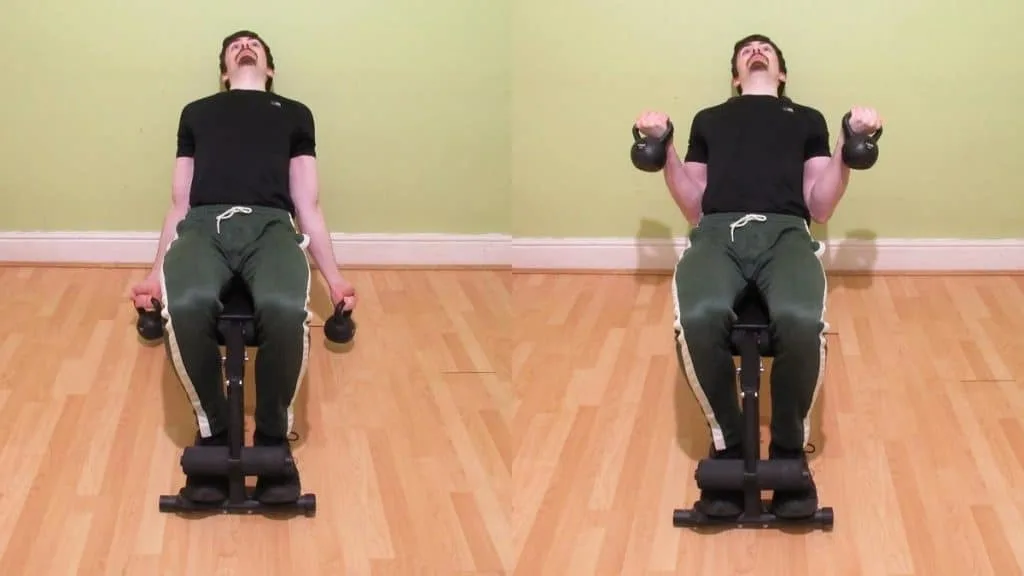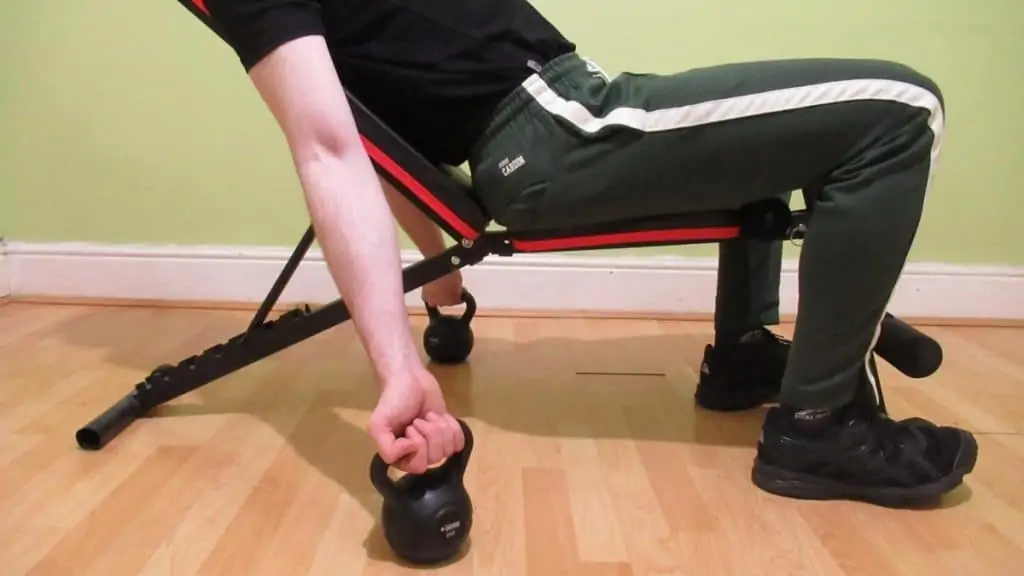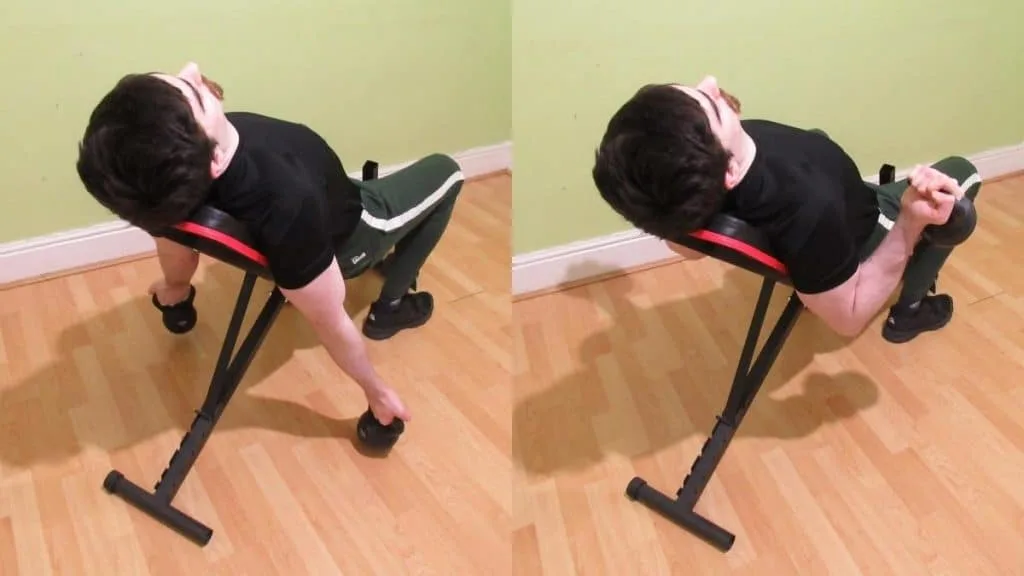Incline kettlebell curls work the long head of the biceps muscle by making you curl with the weights behind your torso. As with seated incline curls, this lifting technique anatomically shifts the emphasis onto the outer muscle fibers of the biceps, which can help you to develop a better peak.
The following tutorial explains how to do a kettlebell bicep curl on an incline bench. Then we’ll move onto the pros and cons of the exercise so that you can decide if it aligns with your arm-building ambitions.
Incline kettlebell curl exercise details
- Main Muscles: Biceps brachii
- Secondary Muscles: Brachioradialis, brachialis, forearm flexors
- Exercise Type: Strength
- Exercise Mechanics: Isolation
- Difficulty Level: Intermediate
- Equipment Needed: Kettlebells, adjustable bench
How to perform incline kettlebell curls

- Set the back pad of an incline bench to a 60-degree angle.
- Hold two kettlebells with an underhand grip.
- Sit on the bench and lie against the backrest with your chest up and shoulder blades pinned back.
- Allow the kettlebells to hang over either side of the bench.
- Curl the kettlebells toward your biceps.
- Keep lifting until your biceps make forceful contact with the undersides of your forearms.
- Hold the contraction for a second and then lower the bells until your elbows are fully locked out.
- Repeat for 3-5 sets of 6-12 reps.
Incline kettlebell curl pros and cons
Out of all the different kettlebell exercises for the biceps, incline curls are one of the most effective movements because they provide relatively consistent tension levels and a satisfyingly deep muscle stretch. That said, there are a couple of drawbacks to the exercise that you should know about as well.
Pro: Better bicep contraction

Kettlebell incline curls generate a more intense muscle contraction than the regular version because kettlebells exert force in a different direction to dumbbells. This results in more consistent tension that makes your biceps work harder throughout the entire repetition. In other words, incline kettlebell curls don’t just give your biceps a great stretch; they give them a powerful contraction too.
Since repeated muscle contractions are what actually cause the much-loved strength training side effect that’s known as the pump, your arms will naturally look learner and more vascular (while training) when you perform exercises that emphasize the peak contraction portion of the rep.
The kettlebell incline curl is one of these exercises and is particularly helpful if you struggle to feel your biceps working in more conventional movements.
Of course, if you’re training at home and don’t have access to much equipment, then you can also do incline curls with resistance bands and get much the same effects.
Con: Kettlebells might hit the floor

If you have long arms or are working out on a weight bench that’s low to the ground, then there’s a decent chance that the kettlebells might hit the floor as you lower them during the eccentric phase of the rep.
There are two possible side-effects to this problem.
First off, if the kettlebells just scrape the floor (and don’t thud into it), then you’ll compromise your lifting rhythm and take tension off the target muscles.
If, on the other hand, the kettlebells smash into the floor, then you should do concentration curls with kettlebells or a similar exercise where you won’t have this problem. After all, if you can’t get a proper stretch without the weights hitting the floor, then you’ll naturally recruit fewer muscle fibers and stimulate less hypertrophy.
Pro: Easy to grip

Kettlebells are easier to grip than dumbbells because less effort is required from your forearm flexors in order to hold onto them.
This makes it easier to feel your biceps working because, by using kettlebells, you no longer have to fight against the forearm activation. In other words, your biceps will receive more of the tension by default.
Moreover, you can perform more reps and sets without worrying about your forearms fatiguing prematurely, which can often be a problem with high-volume bicep training. This is because the kettlebell is essentially resting on the back of your hand during part of the exercise, which means that your forearm flexors don’t have to support it all.
You can also click the link to learn the difference between preacher curls and incline dumbbell curls and find out which exercise is right for you.
Con: Potential lack of progression

Some gyms provide a vast supply of kettlebells to keep you progressing for your whole training career. However, many fitness facilities don’t yet recognize the advantages of functional training; hence, they don’t have complete sets of kettlebells.
The problem with this is that it can be difficult to gain strength when the weight increments are too large. As such, you often end up lifting the same weight for months or even years on end, which makes it hard to gain new muscle tissue once you’ve graduated from low reps to high reps with your current weight.
This is also a problem with Zottman kettlebell curls and other such exercises.
What’s the verdict on incline kettlebell curls?

Incline kettlebell curls provide a great muscle stretch and a potent peak contraction that makes them a dream exercise for any bodybuilding enthusiast.
Since kettlebells are the easiest type of free weight to grip, kettlebell incline curls are also a brilliant movement for anyone who struggles to feel their biceps working during traditional curl exercises.
Just make sure to use a complete range of motion to get the most from this movement. Bring the weight all the way up for an intense bicep contraction, and then lower it under control until your elbows reach full extension for a good muscle stretch.

